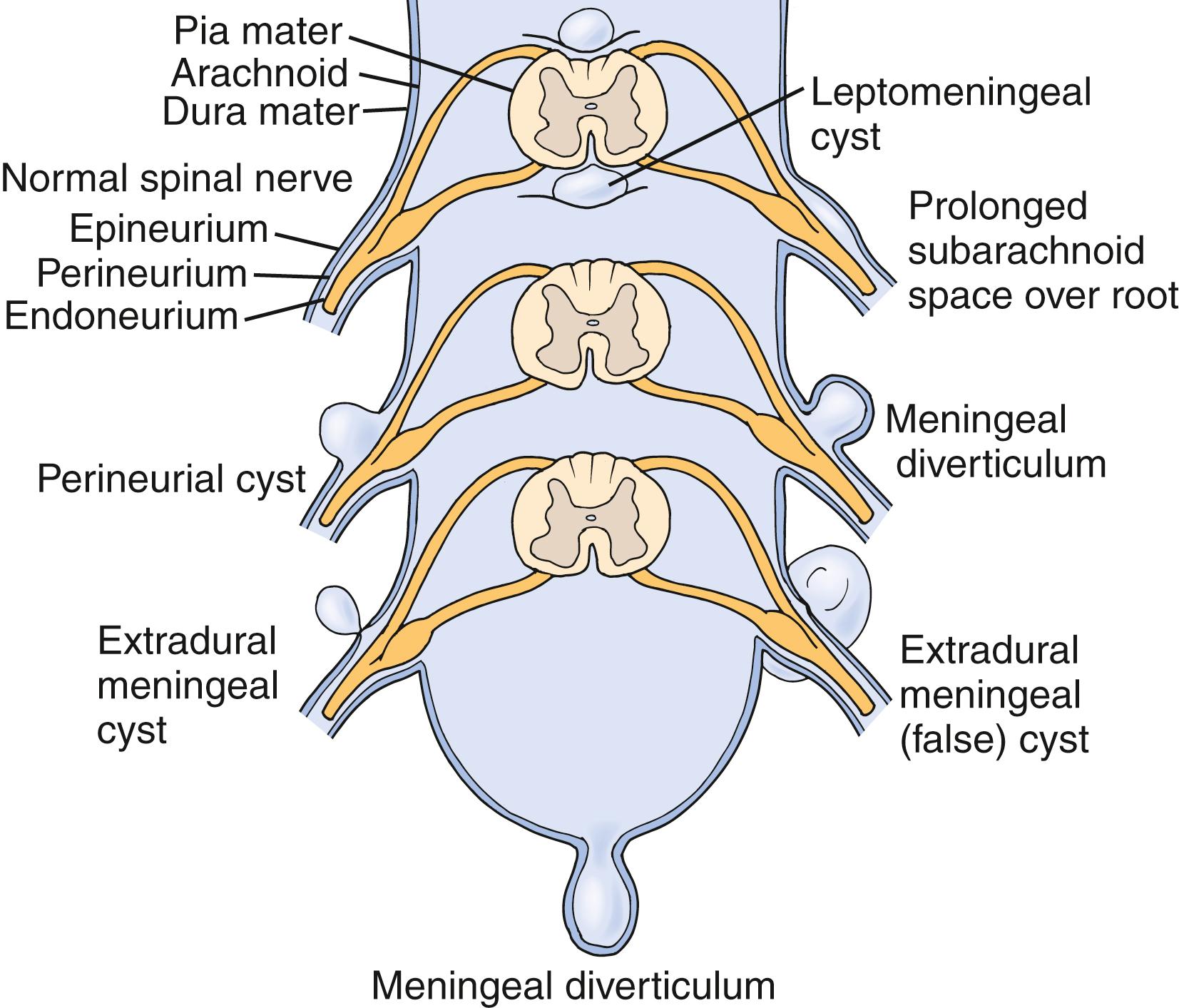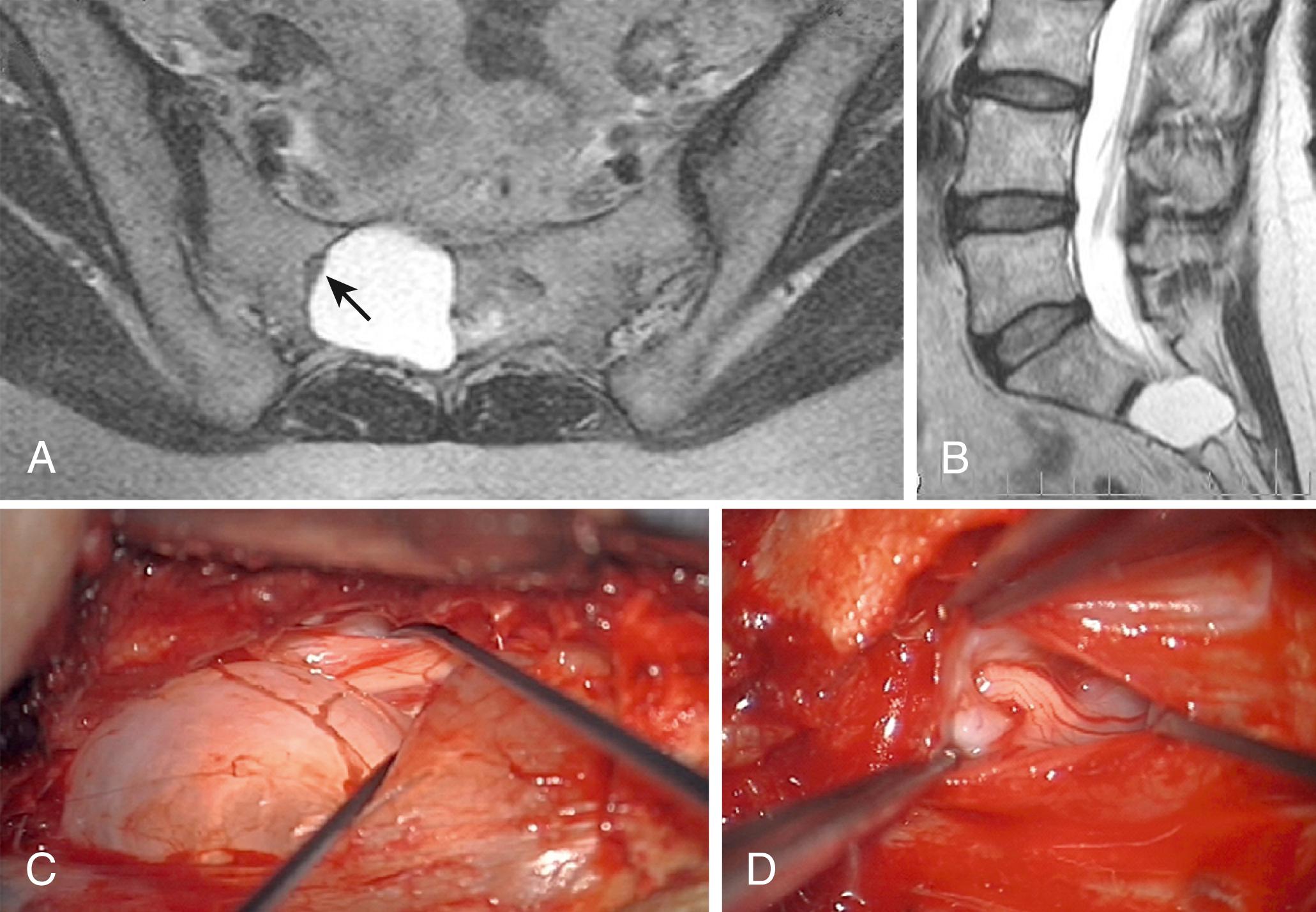Physical Address
304 North Cardinal St.
Dorchester Center, MA 02124
Tarlov cysts are common, occurring in 1% to 2% of persons undergoing spinal magnetic resonance imaging (MRI), particularly in the sacrum. Some 10% to 30% are potentially symptomatic. Sacral nerve root compression by the cyst/s can result in lower back and sacral symptoms, including S1, S2, and S3 radiculopathy, perineal and pelvic pain, and bowel, bladder, or sexual dysfunction that can be disabling to the patient. Pain is exacerbated by sitting or standing, and is generally relieved by lying down. Occasionally, patients present with isolated dyspareunia, vaginal hyperesthesia, or coccydynia.
MRI is the study of choice to evaluate Tarlov cysts, whereas computed tomography myelography results are variable, depending upon the extent of communication of the Tarlov cyst with the spinal sac. Every Tarlov cyst indirectly communicates with the spinal sac and is filled with spinal fluid. Large Tarlov cysts should be differentiated from other types of spinal meningeal cysts, such as intrasacral meningoceles, which are typically much larger, associated with significant bone remodeling or erosion, and sometimes result in sacral insufficiency fracture.
Tarlov cysts appear to occur more commonly in patients with collagen disorders, particularly Marfan and Ehlers–Danlos syndromes, and the hypermobility spectrum disorders.
An image directed diagnostic nerve block to the appropriate nerve can be helpful in confirming whether a Tarlov cyst is the source of the patient’s symptoms.
Microsurgical ablation of the cyst/s is generally effective in relieving pain, depending upon the extent of preoperative injury, and is associated with 88% long-term success. Treatment with aspiration and filling with fibrin glue may give variable improvement in selected patients, but may complicate later surgical treatment.
Tarlov (also known as perineurial) cysts arise on a spinal nerve root at the dorsal root ganglion, and are filled with cerebrospinal fluid (CSF). They are distinct from other spinal meningeal cysts, such as the intrasacral meningocele, meningeal diverticula, ectatic spinal sac cysts, and other forms of dural ectasia. Tarlov cysts occur primarily in the sacral spinal canal, where they produce bone erosion and compression of adjacent spinal nerve roots and cause debilitating sacral radiculopathy syndrome.
Tarlov first described these cysts in 1938 during his autopsy studies of the filum terminale at the Montreal Neurological Institute. The findings in his seminal report, in which he attributed symptoms to the cysts, have been confirmed by a legion of studies. Magnetic resonance imaging (MRI) greatly enhanced our ability to diagnose Tarlov cysts. However, the majority of Tarlov cysts found on MRI are asymptomatic, leading radiologists to underreport their presence and clinicians to overlook and downplay their significance. Moreover, lack of experience with treatment of Tarlov cysts has resulted in a wariness and “hands-off” approach to these lesions. Various therapeutic strategies have been described, trending toward definitive surgical treatment.
Tarlov, or perineurial, cysts are one of the most common forms of meningeal cyst. There are no good epidemiological studies of Tarlov cysts. Estimates vary as to prevalence of meningeal cysts, including Tarlov cysts. A large study of 3535 MRIs revealed a 1.5% incidence of Tarlov cysts ; an incidence of 1% to 2% is accepted in the general population. However, a study of 500 consecutive patients with back pain undergoing lumbosacral MRI demonstrated a 5% incidence of meningeal cysts, one-fifth of which were thought to be symptomatic.
Tarlov cysts, particularly those that are symptomatic, are more common among women. The reason for this is unclear. In Long’s series, there was a male to female ratio of 1:4.5, with ages ranging from 27 to 68 years. This epidemiological disparity may be potentially genetically related, or the result of the hormonal influence of estrogen upon collagenous and other connective tissue constituents of dura mater and perineurial tissue around the spinal nerve roots.
Tarlov distinguished perineurial cysts from other meningeal cysts based on several histological criteria. , , He defined them as perineurial dilations between the endoneurium and perineurium, typically of the S2 or S3 nerve roots, just distal to the dorsal root ganglion ( Fig. 26.1 ). Individual sensory nerve fibers of the root, located along the inner lining of the cyst cavity, distinguishes the Tarlov cyst from other meningeal cyst subtypes, such as meningeal diverticula and arachnoid cysts, wherein the walls are typically devoid of nerve root fibers. Cyst enlargement results in bone erosion, and, presumably through pressure upon adjacent spinal nerve roots, produces radiculopathy.

Sacral, perineal, and leg pain aggravated by sitting should prompt consideration of Tarlov cyst syndrome. In order of decreasing frequency, patients presented with local sacral pain (98.5%), generalized back pain (89%), perineal or pelvic pain (78.9%), sciatica (70.5%), complaints of bladder and or bowel function (72%), and decreased sensation with sexual intercourse (42.6%). Occasionally patients reported isolated dyspareunia, coccydynia (1.5%), or paralysis of plantar or dorsiflexion (each 1%). Importantly, 28% of patients have bowel, bladder, and sexual problems without sciatic pain. Neurogenic bladder may be manifest by urgency, frequency, nocturia, and hesitancy, with the need to perform a Valsalva or Credé maneuver to initiate voiding. Also common are neurogenic bowel symptoms, such as constipation requiring the use of laxatives, or rectal incontinence. Dyspareunia and erectile dysfunction are common.
Sacral Tarlov cysts are characterized by sacral pain, numbness radiating down the backs of the legs in the S1 or S2 dermatomes, perineal pain, rectal pain, and numbness in the S2‒S5 dermatomes. The pain may be “crippling,” and patients report inability to sit, the feeling of “sitting on a rock,” and constantly shifting from hip to hip when seated, with difficulty driving, sitting at a desk, or even engaging in nonwork activities such as dining, going to movies, and sitting through religious services. Many carry cushions or pillows to ameliorate their seated discomfort.
Many patients are told by their medical professionals that Tarlov cysts are asymptomatic, with the obvious inference that there is no reason for the pain which they are reporting. However, the limitations and lower quality of life experienced by these patients may result in loss of employment, depression, marital dysfunction, and divorce.
The more common neurological findings include hypoesthesia in the sacral dermatomes, absent ankle reflex (64%), weakness of plantar flexion (42%), rectal sphincter weakness (29%), and positive straight-leg raising sign (18%).
A Tarlov cyst in the sacral spinal canal arising from the S3 nerve root can cause symptomatic impingement of the ipsilateral S2 nerve root beside it, or of the S4 or S5 nerve root below ( Fig. 26.2 ). A Tarlov cyst can also produce contralateral symptoms if it is large enough to extend across the midline and compress contralateral nerve roots. Nerve root fibers running inside a Tarlov cyst are often splayed out over the inner wall of the cyst, causing in neural fiber alteration and stretching, resulting in pain and sensory deficits.

Become a Clinical Tree membership for Full access and enjoy Unlimited articles
If you are a member. Log in here